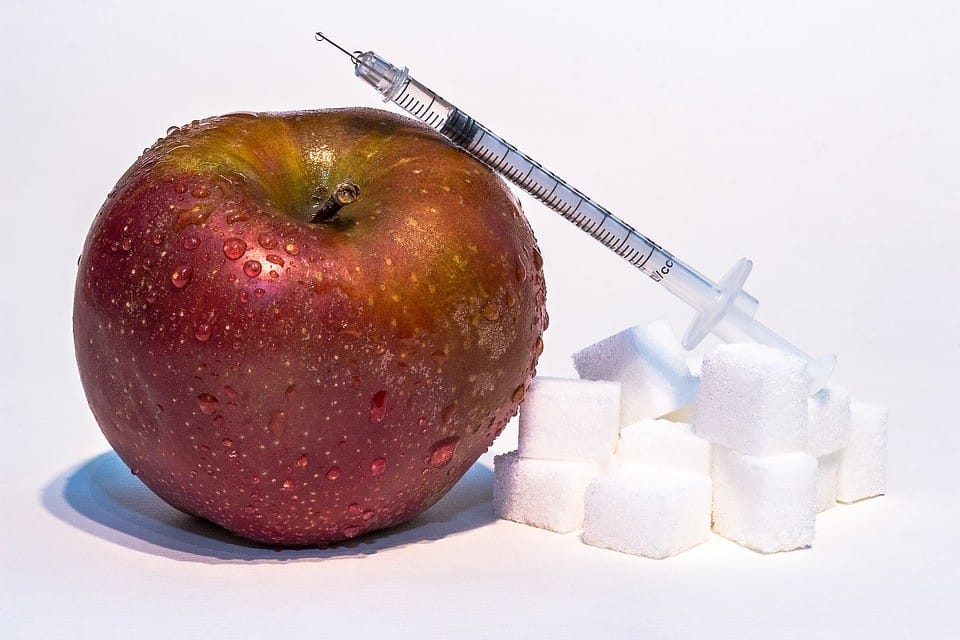The glycemic index (GI) is a measure for determining the effect of a carbohydrate-containing food on the blood sugar level. Sometimes the term “Glyx” is used for this. The higher the value, the more sugar there is in the blood.
How quickly and how high the blood sugar level rises after consuming a food is measured using a certain parameter: the glycemic index or the glycemic load (GL). Carbohydrates are considered to be worse and less healthy the higher their glycemic index or their glycemic load.
The Glycemic Index rates foods from 0 to 100.
The value shows how quickly a food is converted into blood sugar (and thereby increases the insulin level).
Pure glucose has the highest GI of 100. White bread, for example, is 70 to 85 and chocolate and cola are 70. Whilst whole grain products have a GI of 40, legumes and most fruits and vegetables are even lower.
Since a low GI causes blood sugar levels to rise slowly, foods made from whole grains, legumes, and fruits and vegetables hardly put any strain on the pancreas. In general, a food with a GI over 50 is to be regarded as worse than food under 50.
You can see from these examples that the consumption of sugar and carbohydrates has very different effects on the blood sugar level. And you can also see that the sugar from healthy foods only causes slight fluctuations in blood sugar and thus serves to generate energy without harming health.
Because natural sugar in fruits or grains is always present there in a natural combination with many different accompanying substances (including vitamins, minerals and fiber). Isolated and refined forms of sugar, on the other hand, consist (almost) exclusively of sugar. Table sugar made from sucrose, grape sugar made from glucose, fruit sugar made from fructose, etc. These sugars no longer contain accompanying substances. They were removed during production so that only almost 100 percent pure sugar forms are created.
A similar parameter is the insulin index, which indicates the insulin level instead of the blood sugar level. The term glycemic index was introduced in the 1980s as part of diabetes research. It was found that white bread, for example, causes blood sugar to rise more sharply than household sugar after consumption. The difference could not be explained by the structure of the carbohydrates (i.e. complex or small molecule).
There are now several diets that attach importance to the GI, for example the Montignac method, the Glyx diet and the Logi method. More recent research results have shown, however, that the glycemic index, for example, only plays a subordinate role in weight gain and is individually very variable because it depends on the intestinal flora, among other things.
Be careful with the glycemic index
Don’t just blindly take over. Otherwise we come to the point: Fructose does not have a high glycemic index, so we can eat as much of it as we want … so to speak – everything that has a low GI is healthy, so put it in there. That is of course wrong!
Why fructose is disappearing under the radar:
There are a number of reasons why the problematic effects of fructose are only being scrutinized today. For one thing, fructose comes from fruit – and we all know that fruit is so healthy. That may be true if you enjoy it in bulk, say some berries. I’m not talking about high sugar or tropical fruits here.
The second reason is a little more complicated
Carbohydrates are often divided into simple carbohydrates and complex carbohydrates according to their chemical structure. Simple carbohydrates are molecules with one or two sugar molecules, like fructose and glucose. Complex carbohydrates can consist of chains with several thousand sugar molecules. Our body therefore takes longer to break them down. They’re found in vegetables and legumes like beans and lentils and are far better from a nutritional point of view. In the early 1980s, the Glycemic Index (also known as Glyx or GI) was developed so that we could better understand how quickly different carbohydrates can be digested and converted into blood sugar (which our cells then use to generate energy). The index works like a food rating. Foods that can be quickly converted into blood sugar (and cause high insulin secretions) have a high GI: on a scale from 1 to 100, white bread has a value of 85, white rice 89 and instant oatmeal 83. These are recommended Types of foods to avoid. (Remember, a surge in insulin levels keeps the fat in the cells, so these foods indirectly make you fat.) Foods that are more slowly converted to blood sugar and therefore, in theory, are less rude about our metabolism, have a lower GI. For example, chickpeas (10), apples (39) and ice cream (36).
Yes, ice cream! It should be noted that the presence of fat or protein (proteins) in a food lowers the GI value. Since fat does not have an immediate effect on blood sugar levels, fatty foods have a lower index value. Based on this system, carbohydrates have been divided into “good” and “bad” and many nutrition and health experts have adopted this method. Oddly enough, sugary foods have a relatively low GI. Granulated sugar has a lower glyx value than potatoes or white bread. The GI of ice cream is 36 and that of peas is 51.
Do you want to tell us that ice cream is a better choice than rice with vegetables …
Examples:
- White bread GI 85
- White rice GI 89
- Chickpeas GI 10
- Fructose GI 19
According to the GI, fructose would be better than rice if we were to follow the GI.
The reason for this is fructose. Fructose has a GI of around 19, which is very low for fructose. In fact, conventional medicine recommended fructose for a while, especially for diabetics. We know that very little fructose ends up in the bloodstream – but is absorbed by the liver and converted into fat. In the case of granulated sugar or glucose-fructose syrup (corn syrup), the glyx index is low because the fructose does not cause a rise in blood sugar levels – but instead is wreaking havoc elsewhere! The fructose is not in the blood, but ends up in the liver immediately. This connection was suppressed for decades. Now the strongest advocates of fructose come on the scene and must confess their understanding.
Although certain foods have a high GI, they are very low in pure glucose, for example malts such as rice malt and barley malt (around 5%). When consumed in normal amounts, they have negligible effect on glycemia.
Important to know
There is practically no difference between the GI of whole milk products and milk products with a fat content of 0%. However, one should know that dairy products have a high insulin index despite having a low GI.







